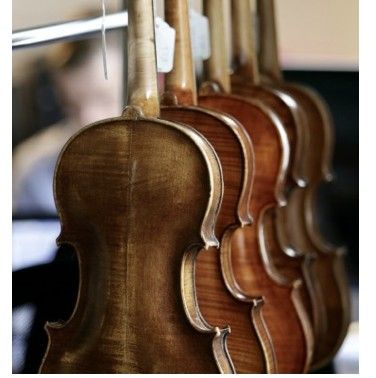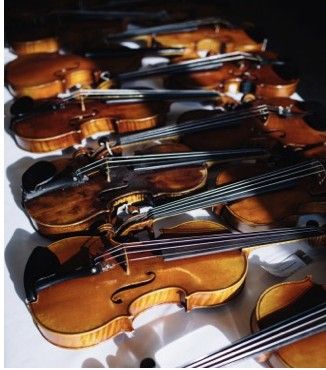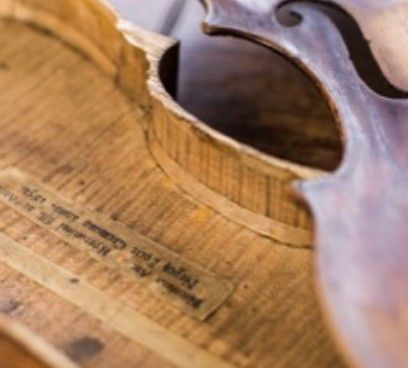Find Your Violin Worth Today
James Omond
He was born in Halkness, South Walls, June 23, 1833, and works as a professional maker at Kirbuster, Stromness, in the Orkneys. He received elementary education at a public school in his native place, and also at the parish school. At the age of sixteen he took charge of a small school in an adjacent island containing only seven families. Soon after he took charge of this school he found that he needed to be better equipped for the profession of a schoolmaster, so he attended the Stromness school at intervals, and also learned navigation. He finally equipped himself for his work at the Edinburgh Training College. After his college career he was appointed master of the society school in the parish of Stromness, where, through pressure of work, his health gave way. He completely lost his voice for eight years, and, after the passing of the Education Act of 1872, he was invalided on a limited pension. He now had to turn his attention to some other means of livelihood, and he picked up watchmaking and repairing. This was not congenial to his tastes, so he decided upon violin-making. To this art he has devoted his time and energies since the year 1873. That he wisely deliberated in his final choice of a calling is amply borne out by the success of his gouge. He succeeded almost from the first, for the mechanical part of the work gave him little or no difficulty. He had learned how to handle edged-tools at the workshop of his father, uncle, and brother, who were general carpenters and boat-builders, and he set about diligently to obtain knowledge of the science of violin construction by corresponding with such authorities as Mr. Horace Petherick, Mr. George Hart, Sec. From the former of these gentlemen he got very valuable hints, and to him he is largely indebted for his success. Mr. Omond was married in 1860 to Jane Groat, of South Walls. He has four sons and one daughter — James, John, Jane, William, and David. He is a genial old gentleman, with a face beaming with Orcadian humour and a heart affectionately attached to the kirk of his forefathers. He spends his time in the company of the great Antony and Joseph, with an occasional excursion to the lonely, weeping Gio. Paolo. He is not a slavish copyist ; on the other hand, he sometimes modifies the lines and vaulting of the masters, and he not infrequently develops the scroll and sound-holes in a manner quite original. The outline measurements are nearly always identical with those of the archetypes, but the thickness of the plates is uniformly greater. One noticeable feature about the sound-holes is the acuteness of the inner angle of the lower wing. This, in a large majority of cases, is developed into a fine point, somewhat after the manner of Otto. Up to the present he has made two hundred instruments, including violins, violas, and violoncellos. The workmanship and finish are perfect — the greatest care being manifest even down to the minutest detail. Mr. Omond's wood is excellent in quality and very often fine in appearance. The grain of the pine is moderately wide, and the " reed " well-defined and straight, showing a healthy growth. He often manages, in spite of his living at so great a distance from a good market, to hit upon a very good piece of sycamore or pine, which he knows well how to use. Mr. Omond has never attempted to make his own varnish. Like a certain king we read of in olden times, he is blest with a sense which is rare amongst men, viz., the sense to know what cannot, as well as what can, be done. He has no knowledge of chemistry, and knows that it would be a waste of time for him to dabble at varnish-making. He uses Caffyn's, or some other good varnish, mostly in amber or orange. He lays it on very carefully, first preparing the surface of the wood to a fine polish, and then with a clean rag dipped in the pale varnish he puts on the first coat in a thin film, so as to prevent it soaking into the wood. The coloured varnish is also put on thin, and each coat allowed good time to dry. Omond's instruments have gained the following awards : — Diplomas of merit at Central International Exhibition, Melbourne, 1888; International Exhibition, Edinburgh, 1890 ; East End Industrial Exhibition, Glasgow, 1891 ; National Trades and Industrial Exhibition, Glasgow, 1895-96. With the last he got a bronze medal, the highest award they gave. It may also be mentioned that at the Fisheries Exhibition, Edinburgh, he obtained a silver medal and £5 for an essay on fishing-boats and a model of an improved boat. He sells his instruments at a very moderate figure, ranging from £3 to £10. He plays well on the fiddle, though with him playing is subsidiary to making, and only taken up comparatively late in life for the purpose of testing his work. Mr. Omond, it may fairly be asserted, is in the front rank of modern Scottish makers. His work is downright honest, unsophisticated, solid British work, and his devotion to the art will materially help to sustain the fame of Scottish violin-makers.
Show more Hide textPrice History
| Type | Title | Sold | Price |
|---|---|---|---|
| Violin | 36.2 cm Stromness, 1895 | Tue 1st May 07 | £ 922.00 |
| Violin | 1908 | Sun 1st October 95 | £ 805.00 |
| Violin | 1902 | Mon 1st November 93 | £ 506.00 |
| Violin | 1902 | Mon 1st February 93 | £ 374.00 |
| Violin | 1906 | Wed 1st November 00 | £ 563.00 |
| Cello | 1898 | Mon 1st March 93 | £ 1540.00 |
Similar Makers
Books by Amati
Amati, in collaboration with leading experts, have published a few key books in the field of stringed instruments.
Explore more


